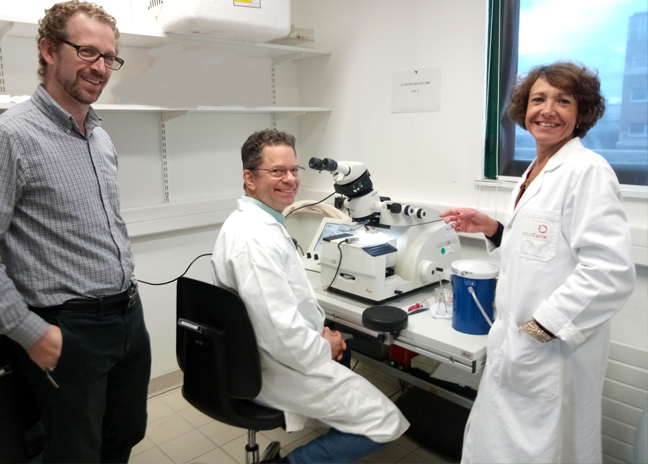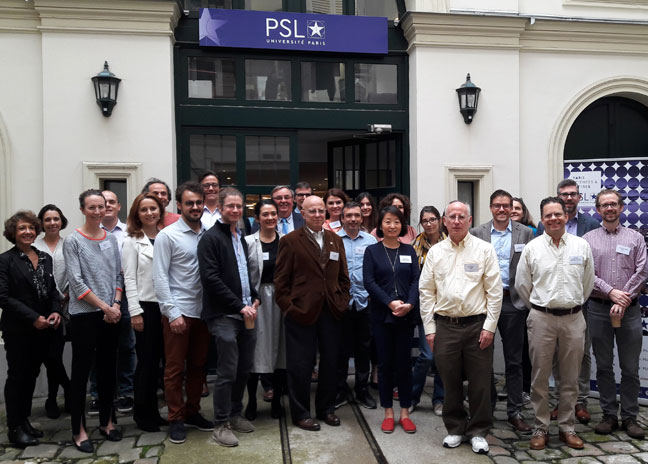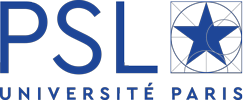“Seeing our Research Topics differently” The PSL-Biogen Doctoral Program
The PSL-Biogen doctoral program has published its third call for applications by PSL research teams. The exchange program, which was launched in 2018 to promote therapeutic research, has given rise to eight dissertation projects on major topics. Each doctoral candidate receives personalized dual mentoring from both PSL researchers and Biogen scientists. Graça Raposo (CNRS research director and Institut Curie team leader), Alexander MC Campbell (Biogen senior director), and Karl Richter (Biogen research engineer and doctoral candidate) discuss their two years of scientific collaboration.

PSL: Karl Richter, you’re a research engineer with Biogen. What made you decide to join the doctoral program?
Karl Richter: Above all, the program is a wonderful opportunity, both personal and professional. It not only offers a new experience to enrich my career, but also allows me to work closely with the neuroscience research laboratory of a major international university like PSL. This connection to the scientific world is a real asset. Research engineers at Biogen closely follow scientific advances in our respective fields, but our work keeps us too busy to test out and put into practice what we’ve read—something I can do as a doctoral candidate in the program. It’s exciting, and it’s helping me round out my understanding of neuroscience. I would have regretted not taking this opportunity.
Call for applications PSL-Biogen doctoral program third edition
PSL: How did you choose your research topic?
Karl’s research topic truly was the result of a joint thought process, first between me and Karl and later with Antoine Triller (ENS - PSL)
Karl Richter: That’s a good question. To define my research subject, we worked with Alexander to determine two prerequisites: the topic needed to explore new techniques in biology and ultimately result in the development of a new therapeutic treatment. We drew up a list of the techniques and tools available within our laboratory that could meet part of the first criterion, then compared them with what was available at PSL. My dissertation topic was supposed to foster complementarity between our approaches, and we decided that I would work on “Interactions of RAN dipeptides with the nuclear envelope and nuclear import and export proteins.”
Alexander McCampbell: Karl’s research topic truly was the result of a joint thought process, first between me and Karl and later with Antoine Triller (ENS - PSL). In fact, he was the one who put us in touch with Graça to develop the project.
Graça Raposo: Yes, the phase of discussion and back-and-forth is extremely important and essential, if only because beyond determining the thesis topic itself, it continues throughout the entire collaboration. Any time we capture a new portion of the cell with a very high resolution image, it has the potential to raise a number of new questions, which may or may not guide our work in a new direction. When I was contacted to be the PSL supervisor for Karl’s work, I accepted right away. Researchers don’t get many opportunities to work closely with industry, let alone in an international context. Still, we have a lot left to discover in the field of cellular biology. These types of collaborations allow us to share our respective experiences, for example in high-resolution imagery, and our different tools and techniques for studying the behavior of cells, as well as our more general experience with conditions such as neurodegenerative diseases. It’s a win-win partnership.
PSL: Each doctoral candidate receives personalized dual mentoring, which is quite novel in France. What do you see as the benefits of this supervision?
The intersection between the basic research and the clinical research are very complementary, and they achieve the common objective of advancing new therapeutic strategies.
Karl Richter: It’s twice as good (laughs)! In all seriousness, one of the main advantages of the dual supervision is that it creates a team-based approach very early on, bringing in different approaches and points of view. In scientific research, it’s impossible for anyone to know or claim to know everything, and differences of opinion are a good thing.
Alexander McCampbell: Indeed, these different perspectives are very enriching both for the dissertation work we’re supervising and for our own respective work. We collaborate and dialog through the international language of science, what more could you ask for!
Graça Raposo: I completely agree, but I do think there’s something important to keep in mind. Joint supervision can work well only if the two mentors are in agreement from the start. Once again, the many discussions that go into preparing for the collaboration are essential, as they were with Karl’s dissertation. In fact, in this particular instance, one of the main benefits I see is the intersection between the basic research conducted at PSL and the clinical research being done at Biogen. Although they are different, the two approaches are very complementary, and they can—and must in some cases—understand one another in order to achieve the common objective of advancing new therapeutic strategies.
An interview with A. Triller and C. Henderson, scientific coordinators for the doctoral program
PSL: Graça Raposo, you serve as CNRS research director at Institut Curie. How do your activities within the PSL-Biogen program, and more specifically your supervision of Karl Richter’s dissertation, fit in with your research work?
We suspect there are multiple connections between the skin and the brain. There are no scientifically solid results yet, but there are intuitions similar to those that guided the work on brain-microbiome connections several years ago. Karl’s research is particularly interesting to me in this sense
Graça Raposo: I am delighted to supervise Karl’s work, and I hope our collaboration will continue well beyond the dissertation. Our exchanges and discussions inspired me with some ideas for new research projects. At Institut Curie, my work and that of my team focus specifically on cellular organelles and how they are altered by different pathologies. By using very high resolution electronic imagery, we are able to observe the changes in cells, including in the specific case of neurodegenerative diseases. The latest research results in this field suggest that there are multiple, unsuspected connections between the skin, which we are studying, and the brain. There are no scientifically solid results yet, but there are intuitions similar to those that guided the work on brain-microbiome connections several years ago. Karl’s research is particularly interesting to me in this sense, because it takes a different approach that may shed some light on certain aspects. It’s important to remember that we’re made up not only of many cells, but of cells with multiple compartments. Observations of them often depend on the observer’s point of view and thus on the research topic itself. By adopting new angles, the PSL-Biogen partnership invites us to see our research subjects differently. It’s exciting and very enriching. The partnership is about more than supervising dissertation work by Karl or anyone else; it is helping to create a scientific community. The two days of seminars at PSL in early October 2019 were extremely productive in this regard.

Deadline for submission: February 24, 2020
Contact information:
- Information and applications packages: biogen@psl.eu
- Yuriko Hirohata - 01 85 73 54 94
- Sonia Litaïem-Cassuto - 01 75 00 02 97
